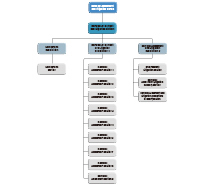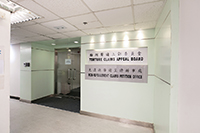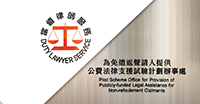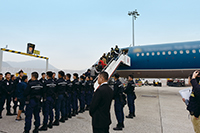Removal Assessment and Litigation Branch
The Removal Assessment and Litigation Branch, which oversees the Removal Assessment and Litigation Division, was established on 20 June 2016. The Branch and its Division are under the command of an Assistant Director and a Principal Immigration Officer respectively.
The Removal Assessment and Litigation Division is responsible for screening claims for non-refoulement protection on all applicable grounds1 against another country lodged by persons not having the right to enter and remain in Hong Kong. The Division also provides support for the government’s comprehensive review of the strategy of handling non-refoulement claims, and handles appeal/petition and litigation cases relating to non-refoulement claims and enforcement.
![]()
Unified Screening Mechanism
Illegal immigrants, overstayers or persons refused entry by the Department upon arrival in Hong Kong do not have legal status to remain in Hong Kong. For effective immigration control and public interest, they should be removed from Hong Kong in accordance with the Immigration Ordinance as soon as practicable.
Pursuant to a number of court rulings, if a person to be removed to another country claims that he would face risks of torture, violation of his absolute and non-derogable rights under the Hong Kong Bill of Rights, or persecution if he is removed to that country, then the Department must withhold the claimant’s removal to that country until his claim is finally determined as unsubstantiated through procedures that meet ‘high standards of fairness’.
To fulfill its obligations under the United Nation Convention against Torture and Other Cruel, Inhuman or Degrading Treatment or Punishment, the Hong Kong Bill of Rights and the Immigration Ordinance, and to execute the relevant court rulings, the government introduced the Unified Screening Mechanism (USM) in March 2014 to determine non-refoulement claims on all applicable grounds. Procedures under the USM follow the statutory procedures under Part VIIC of the Immigration Ordinance, which were passed into law by the Legislative Council in July 2012 following its detailed scrutiny and came into effect in December 2012.
Under the USM, claimants are afforded reasonable opportunities to establish their claims, including through stating relevant details on a non-refoulement claim form and attending a screening interview. After assessment, the Department will inform the claimants of its decision and reasons in writing. Claimants aggrieved by the Department’s decision may lodge an appeal to be considered by the Torture Claims Appeal Board/Non-refoulement Claims Petition Office (Appeal Board), a statutory body independent from the Department.
Throughout the screening process, claimants are also provided with all necessary professional assistance, including publicly-funded legal assistance, interpretation/translation services provided by qualified persons, and medical examination if the alleged physical or mental condition of a claimant is in dispute and is relevant to the claim.
Overall Situation of Non-refoulement Claims
At the commencement of the USM in March 2014, there were a total of 6,699 non-refoulement claims pending screening. As at the end of 2017, the Department had received a further 15,368 claims and determined 10,565 claims, among which 86 claims were substantiated (including 24 claims substantiated at the appeal stage), 5,603 withdrawn, bringing a total number of 5,899 claims pending screening, a substantial decrease of 41 per cent as compared to 9,981 as at the end of 2016. Among those claimants with pending claims, around 80 per cent originated from India, Pakistan, Bangladesh, Indonesia and Vietnam.
Comprehensive Review and Effectiveness
At the early implementation stage of the USM, there had been a significant rise in non-refoulement claims lodged by non-ethnic Chinese illegal immigrants (NECIIs), overstayers and persons having been refused permission to land by the Department upon arrival. The government commenced the comprehensive review of the strategy of handling non-refoulement claims in 2016 in four areas, namely preventing abusers of the non-refoulement claim mechanism from entering Hong Kong, screening procedures, detention, and removal and enforcement. The review had been ongoing and continued to yield results in 2017.
Preventing Abusers of Non-refoulement Claim Mechanism from Entering Hong Kong
To tackle the problems at source, the government endeavoured to prevent illegal immigrants or doubtful visitors with higher immigration risk from coming to Hong Kong. At the early implementation stage of the USM, smuggling via the Mainland was one of the main ways for claimants to enter Hong Kong and the majority of them originated from countries not enjoying visa-free access to Hong Kong, including Vietnam, Pakistan and Bangladesh. The Department was very concerned about the situation, and had been cooperating with the Hong Kong Police Force and the Mainland authorities to step up enforcement actions on boundaries, including liaison and intelligence exchange, and to keep up vigorous joint efforts against these illicit smuggling activities across the boundary and those criminal syndicates that assisting them.
Apart from stepping up enforcement against criminal syndicates, the government put into effect the Immigration (Unauthorized Entrants) (Amendment) Order 2016 in May 2016 to impose heavier penalties on syndicates smuggling illegal immigrants from the eight major source countries of NECIIs, namely Pakistan, Bangladesh, India, Nepal, Sri Lanka, Somalia, Afghanistan and Nigeria. Offenders are liable to up to 14 years of imprisonment and a $5 million fine. Since the implementation of the measures, the number of NECIIs intercepted in 2017 was 893, a drop of almost 60 per cent and 77 per cent as compared with that of 2016 and the peak in 2015, revealing remarkable results.
Moreover, India was a major source country of non-refoulement claimants and that 80 per cent of claimants from India arrived in Hong Kong as visa-free visitors. To strike a balance between providing convenience for bona fide Indian visitors and maintaining effective immigration control, the Department had introduced the ‘Pre-arrival Registration’ (PAR) for Indian Nationals since January 2017, whereby Indian nationals must apply for and successfully complete PAR online before they could visit Hong Kong visa-free. As at the end of 2017, the number of Indian visitors overstaying in Hong Kong had decreased by about 80 per cent as compared with that in 2016. In general, given the effectiveness of the pre-arrival control measures implemented, the number of non-refoulement claims received drastically dropped by 52 per cent from 3,838 claims in 2016 to 1,843 claims in 2017.
Screening Procedures
Meanwhile, to increase the quota of publicly-funded legal assistance, the government had launched the Pilot Scheme for Provision of Publicly-funded Legal Assistance for Non-refoulement Claimants (‘Pilot Scheme’) since September 2017 to run in parallel with the ‘Legal Assistance Scheme for Non-refoulement Claimants’ provided by the Duty Lawyer Service. The maximum daily number of claims for which screening process could commence was thereby increased from 13 before the commencement of the Pilot Scheme to 23, representing an increase of almost 80 per cent. To support various administrative measures to expedite the processing of claims, the Department determined 4,182 claims in 2017, representing a 30 per cent increase as compared to 3,218 claims in 2016.
Moreover, the government was also studying amendments to the Immigration Ordinance in order to provide statutory underpinning to the USM procedures; to tighten the procedural timeframes and to prohibit delaying tactics. The government would report to the Legislative Council on this in due course.
To better support the screening process, the Department provided interpretation service to claimants throughout the screening process. The Department hired in-house translators and interpreters mainly to provide interpretation support for claimants during briefing sessions and screening interviews, as well as to translate documents submitted by claimants. In addition, the Department would hire, on a case basis, part-time non-government interpreters from a pool of about 280 interpreters registered with the Judiciary where necessary.
Detention
The Immigration Ordinance empowers the Department to detain illegal immigrants and other relevant persons pending the determination of non-refoulement claims and/or during the removal process. The exercise of such power must conform to the common law Hardial Singh principle, which states that a person cannot continue to be detained if the screening of non-refoulement claims and removal procedures cannot be completed within a reasonable period of time. As part of the comprehensive review, the government continued to consider options on detention measures from legal, resources, public security implications and other relevant perspectives to better support the management of detention facilities.
Removal and Enforcement
Close Collaboration with Authorities in Other Jurisdictions
In addition, the Department endeavoured to strengthen contact with major source countries of claimants. Following the duty visits to Vietnam, Pakistan and Bangladesh in 2016 to introduce Hong Kong’s stringent legislative provisions and enforcement action against illegal employment and human trafficking, as well as the objectives and implementation of the USM, and to explore cooperation on intelligence gathering and liaison, the Department again sent delegates to Pakistan in 2017 to discuss ways to expedite the removal process. The Department raised our concern over human smuggling and explained the situation regarding non-refoulement claims in Hong Kong. It also strengthened liaison, exchange of intelligence and cooperation with the local law enforcement agencies. In addition, the Department continued to maintain close liaison with local consulates of the source countries concerned to further expedite the removal process.
Litigation Support for Removal Assessment and Enforcement Litigation
A rejected claimant may lodge an appeal, which will be considered by the Appeal Board, an independent statutory body.
The Removal Assessment (Litigation Support) Section is mainly responsible for handling appeals lodged with the Appeal Board and the related judicial reviews.
The Enforcement Litigation Section handles civil litigation cases relating to removal and deportation, and claims for damages relating to detention.







